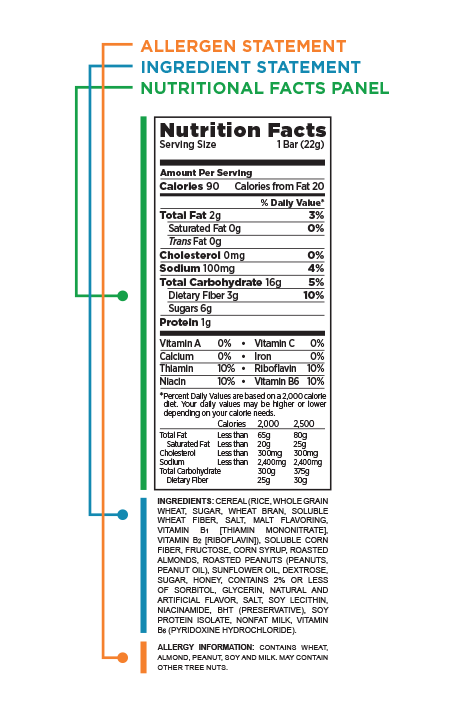What is a Food Allergy?
A food allergy occurs when your immune system reacts to a food protein as if it is a bacteria or virus that needs to be destroyed. Food allergies can be IgE-mediated reactions (immediate), non-IgE-mediated hypersensitivity reactions (delayed), or both. Your body makes its own IgE antibodies to fight against the food allergen. Anytime you eat or drink that food again your body responds by sending out the IgE antibodies to attack the allergen, which releases chemicals that cause an allergic reaction. Allergic reactions range from itchiness or rash to vomiting, to difficulty breathing, to even loss of consciousness. Some individuals that are highly allergic to food can have a reaction from breathing it in or from skin contact. What is especially scary is that allergic reactions can vary with each exposure. The same amount of allergen can cause mild symptoms in one instance, and then cause a severe reaction another time.
Food allergy responses can occur from any food, and individuals can be allergic to multiple different foods, but all food allergies are potentially serious.
The most common food allergens are:
- Milk
- Egg
- Peanut
- Tree nuts
- Soy
- Wheat
- Fish
- Shellfish
Some individuals develop food allergies as kids, and others don’t develop allergies until adulthood. Research suggests that family history and the history of other allergies impact the risk of developing a food allergy. Young children are more likely to develop food allergies than older children and adults. Most children outgrow their food allergies, but adults are less likely to outgrow their food allergy. Another risk factor that increases the risk of a food allergy is having a related medical issue. Some individuals develop a progression of allergic diseases known as Atopic March, which includes eczema, food allergy, allergic rhinitis, and asthma. The National Institute of Allergy and Infectious Diseases (NIAID) released new guidelines in 2017, based off research showing that early introduction of peanut (before 6 months of age), followed by regular consumption, can help protect children at high risk for peanut allergy.
How is a Food Allergy Diagnosed and Treated?
It is important to see a specialist that is a board-certified allergist to have your food allergy evaluated and diagnosed because food allergy symptoms can overlap with symptoms of other medical conditions. Do not try to self-diagnose a food allergy, which can lead to unnecessary dietary restrictions and inadequate nutrition. Avoid unproven methods of food allergy testing that have no definitive studies to show they can effectively diagnose allergies.
An allergist will discuss medical history, ask questions to determine the cause of symptoms and to identify the potential allergens, and perform a physical exam to evaluate and diagnose an allergy.
Next, the allergist may conduct tests to help identify a food allergy. Some scientifically-backed tests that allergists conduct to help identify food allergies are skin prick test, blood test, oral food challenge, and trail elimination diet, which are all proven diagnostic methods. The tests are not 100% accurate and don’t always provide clear answers, but a certified allergist has the proper training to use your test results in combination with the information collected to provide a diagnosis.
There is currently no cure for food allergies. The only way to avoid a reaction is to avoid the allergen. An allergist will determine how long you should avoid food, and if/when you should try introducing it again. Scientists are continuously working toward a better understanding of food allergies through extensive research, to find life-saving treatments. FARE is the world’s largest private source of funding for food allergy research with a mission to improve the quality of life and health of individuals with food allergies.
Guidelines for the Diagnosis and Management of Food Allergy in the United States, published by the National Institute of Allergy and Infectious Diseases (NIAID), is a resource that provides the most updated clinical advice on caring for individuals with food allergies.
The best way to prevent an allergic reaction is to avoid the foods that contain the allergen, and always have epinephrine with you to treat an accidental exposure. Symptoms of a reaction typically appear within minutes after exposure. Reactions can be mild or severe, like anaphylaxis. Even if symptoms appear mild, they can worsen quickly and should be monitored.
What are Symptoms of an Allergic Reaction?
Mild to moderate symptoms include:
- Hives
- Eczema
- Redness of skin
- Itchy mouth or ears
- Nausea/vomiting
- Diarrhea
- Stomach pain
- Runny nose or sneezing
- Dry cough
- Odd taste in mouth.
Severe symptoms include:
- Swelling of lips, tongue and throat that blocks breathing
- Trouble swallowing
- Shortness of breath
- Turning blue
- Drop in blood pressure
- Loss of consciousness
- Chest pain
- Weak pulse
Epinephrine is the first-line treatment for anaphylaxis, and delaying administering epinephrine can be dangerous with severe symptoms. Young children may not be able to communicate symptoms, so adults should be able to recognize signs of an allergic reaction.
Signs of an allergic reaction in children include:
- Putting hands in their mouth
- Scratching at their tongue
- Change in voice
- Slurring words
What is the Difference Between a Food Allergy and Food Intolerance?
A food allergy is not the same as a food intolerance because intolerances do not involve a response from the immune system. Some food intolerances may cause similar symptoms as a true food allergy, but they cannot lead to an anaphylactic reaction. The two most common food intolerances are lactose intolerance and Celiac Disease.
Individuals with lactose intolerance are unable to digest foods containing lactose due to a lack of enzyme lactase, which breaks down lactose in dairy products. Celiac Disease is an adverse reaction to the protein gluten, which is found in wheat, rye, barley. Individuals with celiac disease must avoid foods containing gluten. When someone with Celiac consumes gluten an immune response occurs and can damage the lining of the small intestine, which prevents the body from properly absorbing the nutrients in food.
How to Read a Food Label for Allergens
The Food Allergen Labeling and Consumer Protection Act of 2004 (FALCPA) made it easier for individuals with food allergies to identify allergens in food products. The law only covers the eight major allergens; milk, egg, peanut, tree nut, soy, wheat, fish, and shellfish, but is required on all packaged foods sold in the United States. It is required that the allergen is listed on the food label even if the amount is very small. They can be identified on the food label in one of three ways:
- Ingredient list – i.e. low-fat milk
- “Contains” followed by the food allergen – i.e. contains milk
- In parentheses when the ingredient is a less common form of the allergen – i.e. Lactalbumin (milk)
Other warnings to be aware of on the label are statements like; “may contain”, “made on equipment with”, “processed in a facility that also processes”, which indicate that there could be potential of cross-contamination of an allergen even if the product does not contain the allergen. Statements like “egg-free” and “peanut-free” are not regulated, so it is important to be familiar with foods that often contain an allergen, and other names it can be called to ensure you or your loved one does not accidentally consume a product containing that allergen.
Take-away Message
Food allergies are on the rise. The Centers for Disease Control & Prevention reports that the prevalence of food allergy in children increased by 50 percent between 1997 and 2011. Most fatal food allergy reactions are triggered by food consumed outside the home, which is why it is so important to raise awareness and educate others on food allergies to keep those with allergies safe. FARE and other scientists continue to research food allergies to gain a better understanding of food allergies, develop effective treatments, and hopefully find a cure for those suffering from food allergies. If you suspect that you or a loved one has a food allergy, set up an appointment with your primary care provider to get a consult with a board-certified allergist.



